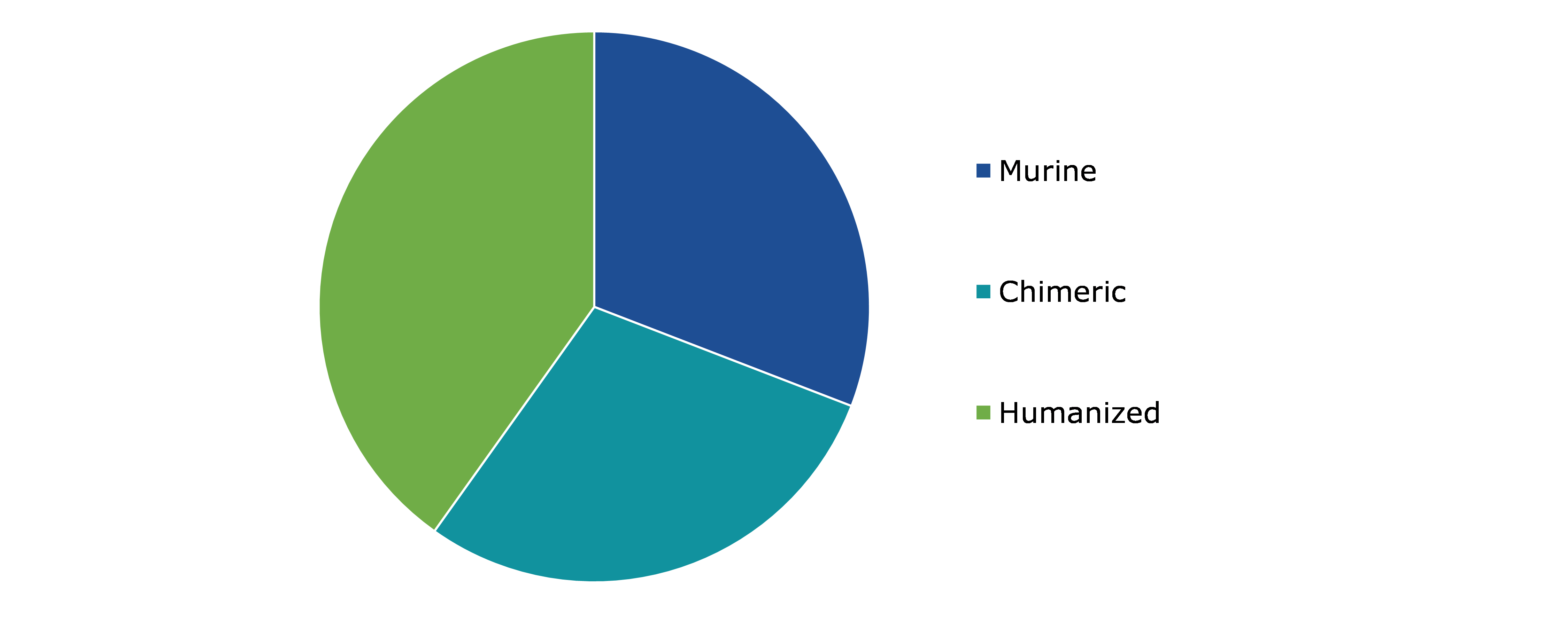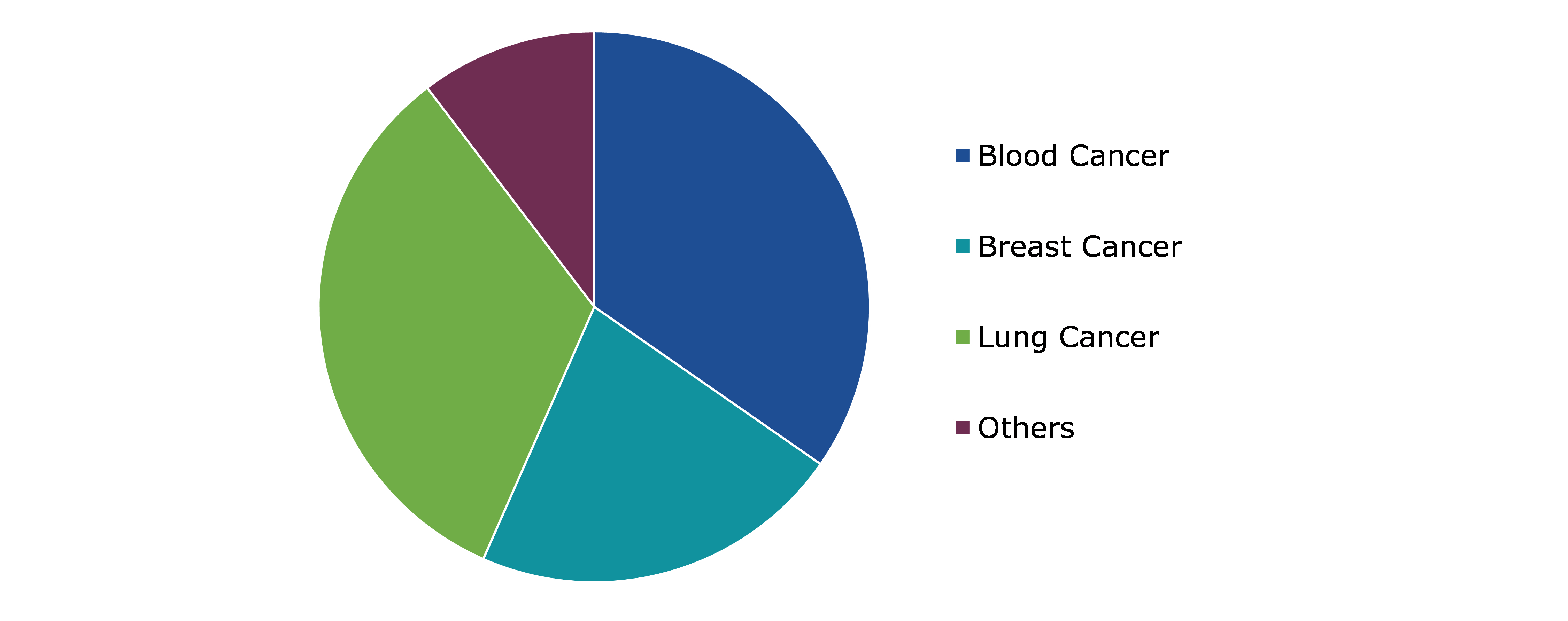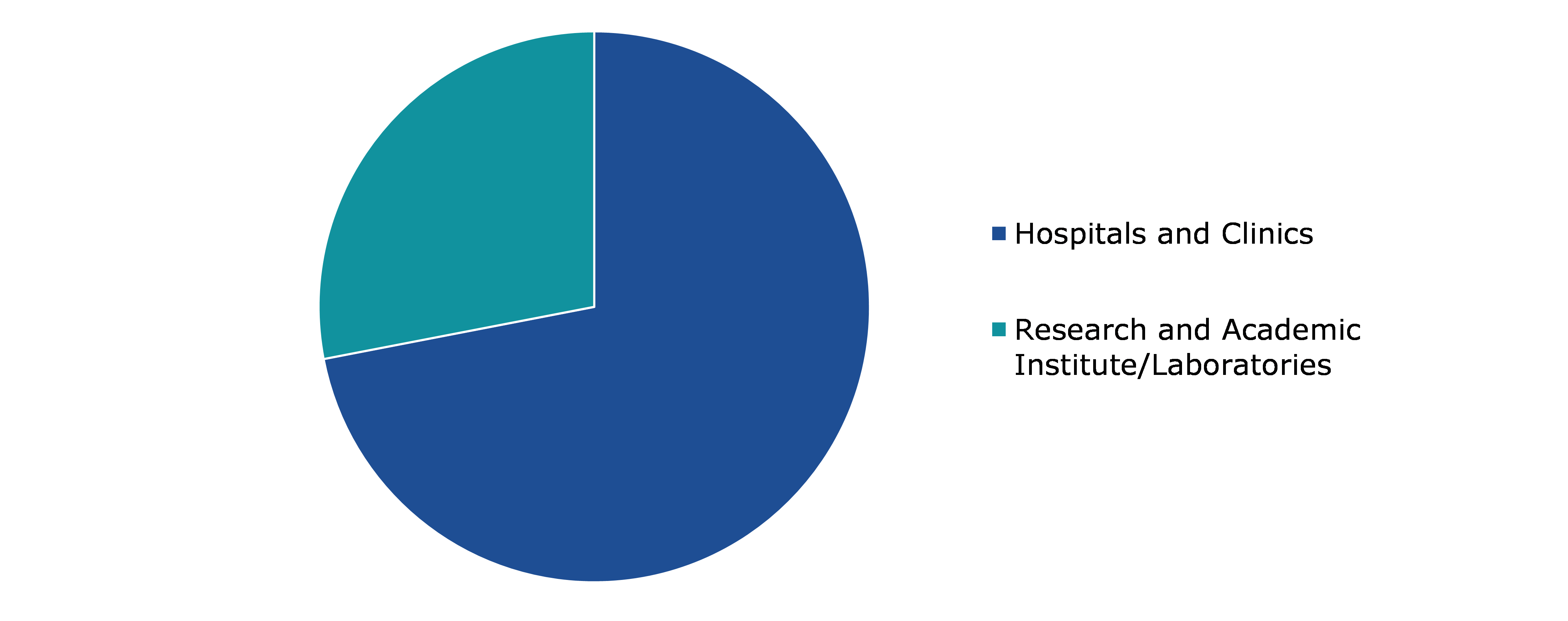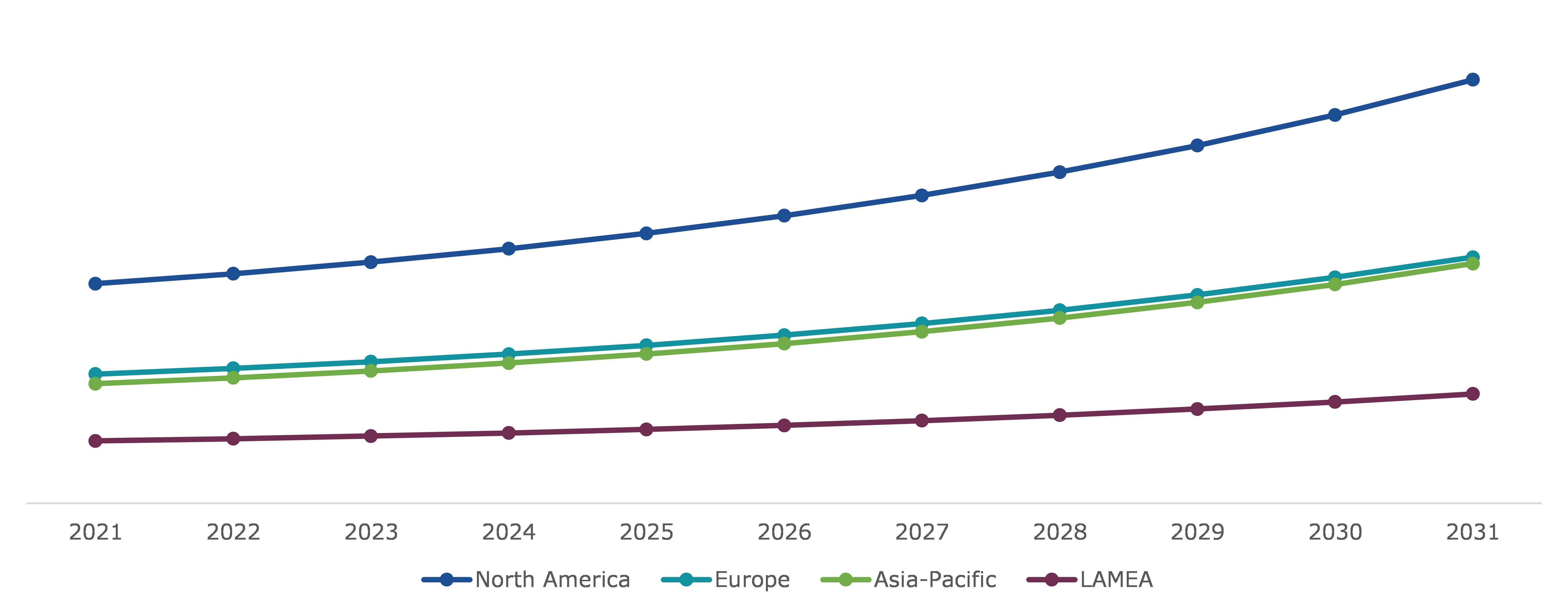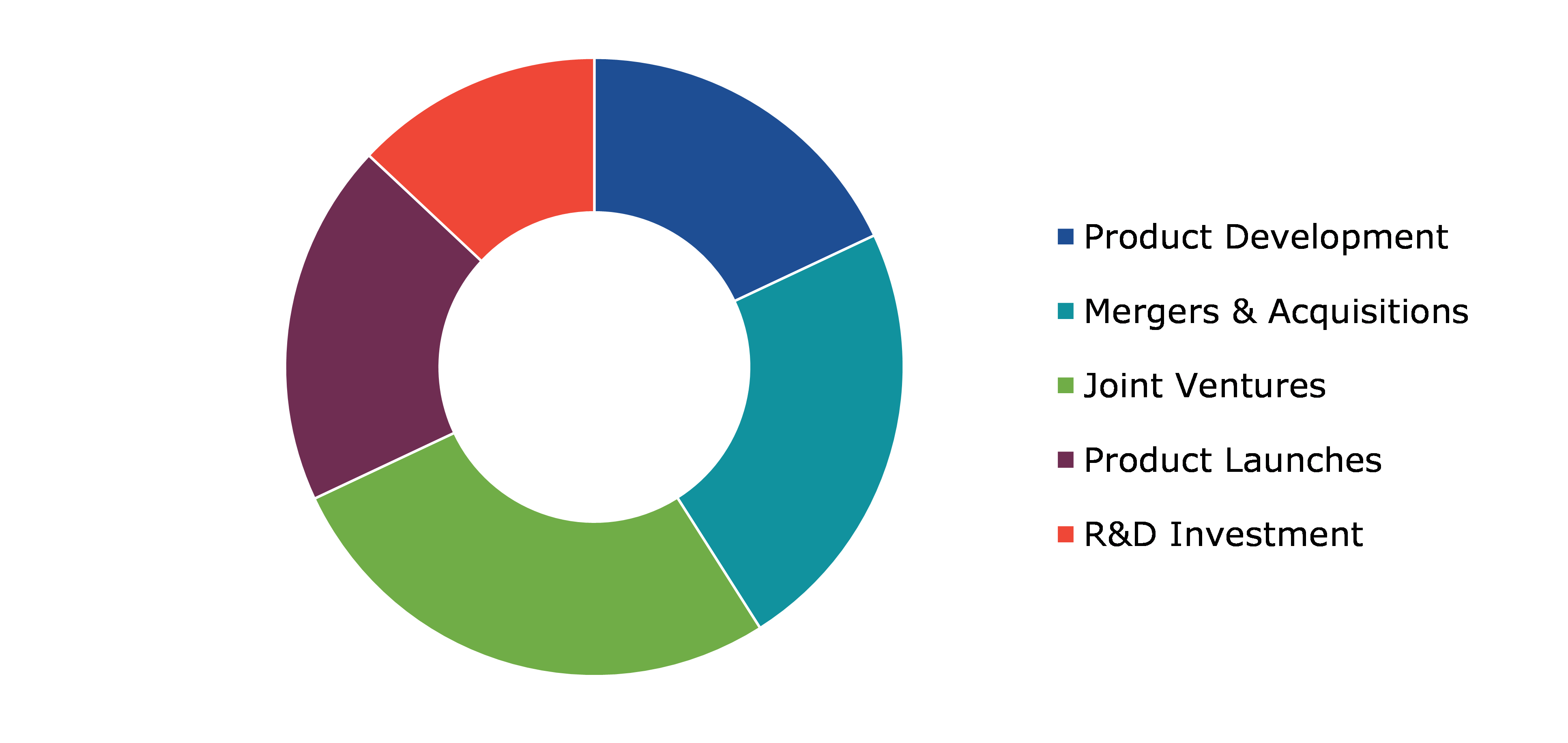Cancer Monoclonal Antibodies Market Report
RA08638
Cancer Monoclonal Antibodies Market by Antibody Type (Murine, Chimeric, and Humanized), Application (Blood Cancer, Breast Cancer, Lung Cancer, and Others), End User (Hospitals and Clinics and Research and Academic Institutes/Laboratories), and Regional Analysis (North America, Europe, Asia-Pacific, and LAMEA): Global Opportunity Analysis and Industry Forecast, 2022-2031
Global Cancer Monoclonal Antibodies Market Analysis
The Global Cancer Monoclonal Antibodies Market Size was $55,640.00 million in 2021 and is predicted to grow with a CAGR of 7.0%, by generating a revenue of $106,825.10 million by 2031.
Global Cancer Monoclonal Antibodies Market Synopsis
The growing incidences of cancer among people globally are expected to drive the cancer monoclonal antibodies market share growth during the forecast time. Cancer is among the top chronic diseases which affect more than a million people and is responsible for many deaths across the world. Thus, to lower the severity caused by the disease, the demand for potent treatment options has increased which is expected to boost the demand for cancer monoclonal antibodies in the upcoming years.
The market growth is expected to be restricted owing to the non-availability of skilled professionals and researchers for developing cancer monoclonal antibodies for the treatment of cancer during the forecast period. Also, the high treatment cost of cancer is further expected to restrain the cancer monoclonal antibodies market growth in the future.
Increase in government support through an increase in funding for cancer monoclonal antibodies and expanded reimbursement policies to enable common people to benefit from newly developed cancer treatment aids in accelerating the market growth for cancer monoclonal antibodies during the forecast period.
According to regional analysis, the North America cancer monoclonal antibodies market accounted for a dominating market share in 2021. The regional growth is majorly attributed to extensive research going on in the field of cancer and treatment options like cancer monoclonal antibodies and chemotherapy by the researchers.
Cancer Monoclonal Antibodies Overview
Monoclonal antibodies (MABs) are a targeted drug therapy that is used for treating cancer in patients. These medications detect and locate certain proteins in cancer cells. MABs are used to treat cancer in a variety of ways. They function in various ways to either kill or inhibit the growth of cancer cells. Many types of cancers are treated using monoclonal antibodies. These antibodies are administered to patients via infusion and can be used alone or in conjunction with other cancer treatments. Depending on the antigen targeted, each monoclonal antibody functions in one or more ways.
COVID-19 Impact on Global Cancer Monoclonal Antibodies Market
The COVID-19 pandemic has had a negative impact on the cancer monoclonal antibodies industry. The pandemic has had a negative impact on cancer awareness, prevention, diagnosis, and treatment, owing to the lockdown, travel restrictions, and widespread fear. Cancer treatment using monoclonal antibodies became challenging during the pandemic period. The treatment was more challenging due to patients' poor or impaired immunity and vulnerability to infection. Certain cancer medications can lower immunity, exacerbating the negative effects if the patient is also impacted by COVID-19. During the COVID-19 pandemic, the pharmaceutical sector was more focused on developing a COVID-19 vaccination. Therefore, R&D activities for cancer monoclonal antibodies decreased, despite the fact that demand for cancer monoclonal antibodies was stable and robust before to the pandemic. Such factors are expected to drive the cancer monoclonal antibodies market share growth in the post-pandemic era.
Growing Prevalence of Cancer Globally Projected to Drive the Market Growth
The need for effective drugs and vaccines has increased due to the increase in the frequency of cancer cases worldwide and this has encouraged researchers and scientists to pace up their research activities and develop effective treatment options. Cancer is one of the leading causes of death, globally, and every year, cancer cases are increasing globally at a rapid rate. For instance, according to statistics by the National Cancer Institute, in 2020, approximately 18.1 million new cancer cases were reported and 9.5 million cancer-related deaths worldwide. It is expected that by 2040, the number of new cancer cases expected to reach up to 29.5 million and the number of deaths related to cancer to reach 16.4 million. Thus, the growing number of cancer cases, worldwide, has raised the demand for effective treatment therapy which is projected to boost the market growth during the forecast period.
To know more about global cancer monoclonal antibodies market drivers, get in touch with our analysts here.
High Cost of Cancer Monoclonal Antibody Therapy to Restrain the Market Growth
The cancer monoclonal antibodies testing market size growth is expected to be hampered by a shortage of skilled professionals and unawareness among patients regarding the potential treatment choices for this ailment. Also, the high costs associated with the treatment of cancer using cancer monoclonal antibody targeted therapy are expected to limit the market growth. Many of the monoclonal antibody medicines required to treat cancer disease are costly, making it difficult for many people to afford this treatment option, particularly those living in rural areas. Therefore, the market is expected to suffer severely. All such factors are likely to hinder the cancer monoclonal antibodies market revenue growth during the forecast period.
Scientific Advancements in the R&D Field in Pharmaceutical and Biotechnology Field to Drive the Market Opportunities
Increase in R&D activities, government support for cancer projects, and a rise in demand for effective medicine and therapies for various chronic cancer types like breast cancer and liver cancer are factors contributing to the growth of the cancer monoclonal antibodies market share during the forecast period. Recently, the cancer monoclonal antibodies therapy has gained popularity among researchers and healthcare professionals as this therapy is a targeted therapy that directly interacts with cancer cells, thereby either controlling their growth or killing them. Also, the manufacturers prevalent in the pharmaceutical and biotechnological field are adopting various growth strategies to develop cancer monoclonal antibody therapy and also increase their share in the global market. For instance, on January 17, 2023, Leap Therapeutics, Inc., a global biotechnology company developing targeted and immuno-oncology therapeutics, announced its merger agreement with Flame Biosciences, Inc., a private biotechnology company. With this merger, Leap Therapeutics acquired Flame’s all monoclonal antibody projects including FL-301, its clinical stage anti-Claudin18.2 monoclonal antibody, FL-302, its preclinical anti-Claudin18.2/CD137 bispecific monoclonal antibody, and FL-501, its preclinical anti-GDF15 monoclonal antibody. All these factors are likely to create several growth opportunities for key players operating in the cancer monoclonal antibodies market growth during the forecast time.
To know more about global cancer monoclonal antibodies market opportunities, get in touch with our analysts here.
Global Cancer Monoclonal Antibodies Market, by Antibody Type
By antibody type, the market has been divided into murine, chimeric, and humanized. Among these, the murine segment accounted for a dominant market share in 2021 and the humanized segment is anticipated to show the fastest growth during the forecast period.
Global Cancer Monoclonal Antibodies Market Size, by Antibody Type, 2021
Source: Research Dive Analysis
The murine segment accounted for a dominant market share in 2021. Murine monoclonal antibodies are significant and are frequently utilized as building blocks for antibody development approaches. Furthermore, this technology and subsequent generation of murine antibodies remain a popular and cost-effective approach of producing novel antibodies owing to the maturity and improved procedures for antibody synthesis from hybridoma mouse cell lines.
Global Cancer Monoclonal Antibodies Market, by Application
By application, the market has been divided into blood cancer, breast cancer, lung cancer, and others. Among these, the blood cancer segment accounted for a dominant market share in 2021 and the lung cancer segment is anticipated to witness the fastest growth during the forecast period.
Global Cancer Monoclonal Antibodies Market Share, by Application, 2021
Source: Research Dive Analysis
The blood cancer segment accounted for a dominant market share in 2021. The rise in cases of blood cancer among people, globally, has increased the demand for cancer monoclonal antibody treatment. Over the last three years, there has been a tremendous growth in demand for hematological problem therapies, prompting pharmaceutical companies to produce innovative drugs such as cancer monoclonal antibodies.
Global Cancer Monoclonal Antibodies Market, by End User
By end user, the market has been divided into hospitals and clinics and research and academic institutes/laboratories. Among these, the hospitals & clinics segment accounted for a dominant market share in 2021 and is anticipated to witness the fastest growth during the forecast time.
Global Cancer Monoclonal Antibodies Market Growth, by End User, 2021
Source: Research Dive Analysis
The research and academic institutes/laboratories segment accounted for a considerable market share in 2021. The government and academic institutions are working to develop novel therapeutics using cancer monoclonal antibodies techniques. This has resulted in more government support for the chronic disease development sector, especially cancer, better treatment, and new technologies, as well as more R&D and enhanced usage.
Global Cancer Monoclonal Antibodies Market, Regional Insights
The cancer monoclonal antibodies market was analyzed across North America, Europe, Asia-Pacific, and LAMEA.
Global Cancer Monoclonal Antibodies Market Size & Forecast, by Region, 2021-2031 ($ Million)
Source: Research Dive Analysis
The Cancer Monoclonal Antibodies Market in North America to be the Most Dominant
The North America cancer monoclonal antibodies market size accounted for a dominating market share in 2021. The region offers tremendous growth opportunities for the major players operating in the cancer monoclonal antibodies market. The market for cancer monoclonal antibodies is expected to grow in North America owing to the growing prevalence of cancer among people, increasing demand for treatment options, and rising R&D activities on new target-based therapies. Also, established technologically advanced R&D centers and the availability of experienced researchers in the region are further anticipated to drive the regional market growth during the forecast period.
Competitive Scenario in Global Cancer Monoclonal Antibodies Market
Investment and agreement are common strategies followed by major market players. In 2020, Merck launched the biosimilar trastuzumab, a monoclonal antibody used to treat certain breast cancers.
Source: Research Dive Analysis
The key players profiled in this report include F. Hoffmann-La Roche Ltd., Bristol Myers, Squibb Co., Merck & Co., GlaxoSmithKline plc, Johnson & Johnson, Amgen, Inc., Novartis AG, AstraZeneca plc, Eli Lilly and Company, and AbbVie.
| Aspect | Particulars |
| Historical Market Estimations | 2020 |
| Base Year for Market Estimation | 2021 |
| Forecast Timeline for Market Projection | 2022-2031 |
| Geographical Scope | North America, Europe, Asia-Pacific, and LAMEA |
| Segmentation by Antibody Type |
|
| Segmentation by Application |
|
| Segmentation by End User |
|
| Key Companies Profiled |
|
Q1. What is the size of the global cancer monoclonal antibodies market?
A. The global cancer monoclonal antibodies market size was $55,640.00 million in 2021 and is predicted to grow with a CAGR of 7.0%, by generating a revenue of $106,825.10 million by 2031.
Q2. Which are the major companies in the cancer monoclonal antibodies market?
A. F. Hoffmann-La Roche Ltd., Bristol Myers, and Squibb Co. are the major companies in the global cancer monoclonal antibodies market.
Q3. Which region, among others, possesses greater investment opportunities in the future?
A. Asia-Pacific possesses great investment opportunities for investors in the future.
Q4. What will be the growth rate of the North America cancer monoclonal antibodies market?
A. North America cancer monoclonal antibodies market is anticipated to grow at a CAGR of 7.0% during the forecast period.
Q5. What are the strategies opted by the leading players in the market?
A. Agreement and investment are the two key strategies opted by the operating companies in this market.
1.Research Methodology
1.1.Desk Research
1.2.Real time insights and validation
1.3.Forecast model
1.4.Assumptions and forecast parameters
1.5.Market size estimation
1.5.1.Top-down approach
1.5.2.Bottom-up approach
2.Report Scope
2.1.Market definition
2.2.Key objectives of the study
2.3.Report overview
2.4.Market segmentation
2.5.Overview of the impact of COVID-19 on Global cancer monoclonal antibodies market
3.Executive Summary
4.Market Overview
4.1.Introduction
4.2.Growth impact forces
4.2.1.Drivers
4.2.2.Restraints
4.2.3.Opportunities
4.3.Market value chain analysis
4.3.1.List of raw material suppliers
4.3.2.List of manufacturers
4.3.3.List of distributors
4.4.Innovation & sustainability matrices
4.4.1.Technology matrix
4.4.2.Regulatory matrix
4.5.Porter’s five forces analysis
4.5.1.Bargaining power of suppliers
4.5.2.Bargaining power of consumers
4.5.3.Threat of substitutes
4.5.4.Threat of new entrants
4.5.5.Competitive rivalry intensity
4.6.PESTLE analysis
4.6.1.Political
4.6.2.Economical
4.6.3.Social
4.6.4.Technological
4.6.5.Environmental
4.7.Impact of COVID-19 on Cancer Monoclonal Antibodies market
4.7.1.Pre-covid market scenario
4.7.2.Post-covid market scenario
5.Cancer Monoclonal Antibodies Market Analysis, by Antibody Type
5.1.Overview
5.2.Murine
5.2.1.Definition, key trends, growth factors, and opportunities
5.2.2.Market size analysis, by region, 2021-2031
5.2.3.Market share analysis, by country, 2021-2031
5.3.Chimeric
5.3.1.Definition, key trends, growth factors, and opportunities
5.3.2.Market size analysis, by region, 2021-2031
5.3.3.Market share analysis, by country, 2021-2031
5.4.Humanized
5.4.1.Definition, key trends, growth factors, and opportunities
5.4.2.Market size analysis, by region, 2021-2031
5.4.3.Market share analysis, by country, 2021-2031
5.5.Research Dive Exclusive Insights
5.5.1.Market attractiveness
5.5.2.Competition heatmap
6.Cancer Monoclonal Antibodies Market Analysis, by Application
6.1.Overview
6.2.Blood Cancer
6.2.1.Definition, key trends, growth factors, and opportunities
6.2.2.Market size analysis, by region, 2021-2031
6.2.3.Market share analysis, by country, 2021-2031
6.3.Breast Cancer
6.3.1.Definition, key trends, growth factors, and opportunities
6.3.2.Market size analysis, by region, 2021-2031
6.3.3.Market share analysis, by country, 2021-2031
6.4.Lung Cancer
6.4.1.Definition, key trends, growth factors, and opportunities
6.4.2.Market size analysis, by region, 2021-2031
6.4.3.Market share analysis, by country, 2021-2031
6.5.Others
6.5.1.Definition, key trends, growth factors, and opportunities
6.5.2.Market size analysis, by region, 2021-2031
6.5.3.Market share analysis, by country, 2021-2031
6.6.Research Dive Exclusive Insights
6.6.1.Market attractiveness
6.6.2.Competition heatmap
7.Cancer Monoclonal Antibodies Market Analysis, by End User
7.1.Overview
7.2.Hospitals and Clinics
7.2.1.Definition, key trends, growth factors, and opportunities
7.2.2.Market size analysis, by region, 2021-2031
7.2.3.Market share analysis, by country, 2021-2031
7.3.Research and Academic Institutes/Laboratories
7.3.1.Definition, key trends, growth factors, and opportunities
7.3.2.Market size analysis, by region, 2021-2031
7.3.3.Market share analysis, by country, 2021-2031
7.4.Research Dive Exclusive Insights
7.4.1.Market attractiveness
7.4.2.Competition heatmap
8.Cancer Monoclonal Antibodies Market, by Region
8.1.North America
8.1.1.U.S.
8.1.1.1.Market size analysis, by Antibody Type
8.1.1.2.Market size analysis, by Application
8.1.1.3.Market size analysis, by End User
8.1.2.Canada
8.1.2.1.Market size analysis, by Antibody Type
8.1.2.2.Market size analysis, by Application
8.1.2.3.Market size analysis, by End User
8.1.3.Mexico
8.1.3.1.Market size analysis, by Antibody Type
8.1.3.2.Market size analysis, by Application
8.1.3.3.Market size analysis, by End User
8.1.4.Research Dive Exclusive Insights
8.1.4.1.Market attractiveness
8.1.4.2.Competition heatmap
8.2.Europe
8.2.1.Germany
8.2.1.1.Market size analysis, by Antibody Type
8.2.1.2.Market size analysis, by Application
8.2.1.3.Market size analysis, by End User
8.2.2.UK
8.2.2.1.Market size analysis, by Antibody Type
8.2.2.2.Market size analysis, by Application
8.2.2.3.Market size analysis, by End User
8.2.3.France
8.2.3.1.Market size analysis, by Antibody Type
8.2.3.2.Market size analysis, by Application
8.2.3.3.Market size analysis, by End User
8.2.4.Spain
8.2.4.1.Market size analysis, by Antibody Type
8.2.4.2.Market size analysis, by Application
8.2.4.3.Market size analysis, by End User
8.2.5.Italy
8.2.5.1.Market size analysis, by Antibody Type
8.2.5.2.Market size analysis, by Application
8.2.5.3.Market size analysis, by End User
8.2.6.Rest of Europe
8.2.6.1.Market size analysis, by Antibody Type
8.2.6.2.Market size analysis, by Application
8.2.6.3.Market size analysis, by End User
8.2.7.Research Dive Exclusive Insights
8.2.7.1.Market attractiveness
8.2.7.2.Competition heatmap
8.3.Asia-Pacific
8.3.1.China
8.3.1.1.Market size analysis, by Antibody Type
8.3.1.2.Market size analysis, by Application
8.3.1.3.Market size analysis, by End User
8.3.2.Japan
8.3.2.1.Market size analysis, by Antibody Type
8.3.2.2.Market size analysis, by Application
8.3.2.3.Market size analysis, by End User
8.3.3.India
8.3.3.1.Market size analysis, by Antibody Type
8.3.3.2.Market size analysis, by Application
8.3.3.3.Market size analysis, by End User
8.3.4.Australia
8.3.4.1.Market size analysis, by Antibody Type
8.3.4.2.Market size analysis, by Application
8.3.4.3.Market size analysis, by End User
8.3.5.South Korea
8.3.5.1.Market size analysis, by Antibody Type
8.3.5.2.Market size analysis, by Application
8.3.5.3.Market size analysis, by End User
8.3.6.Rest of Asia-Pacific
8.3.6.1.Market size analysis, by Antibody Type
8.3.6.2.Market size analysis, by Application
8.3.6.3.Market size analysis, by End User
8.3.7.Research Dive Exclusive Insights
8.3.7.1.Market attractiveness
8.3.7.2.Competition heatmap
8.4.LAMEA
8.4.1.Brazil
8.4.1.1.Market size analysis, by Antibody Type
8.4.1.2.Market size analysis, by Application
8.4.1.3.Market size analysis, by End User
8.4.2.Saudi Arabia
8.4.2.1.Market size analysis, by Antibody Type
8.4.2.2.Market size analysis, by Application
8.4.2.3.Market size analysis, by End User
8.4.3.UAE
8.4.3.1.Market size analysis, by Antibody Type
8.4.3.2.Market size analysis, by Application
8.4.3.3.Market size analysis, by End User
8.4.4.South Africa
8.4.4.1.Market size analysis, by Antibody Type
8.4.4.2.Market size analysis, by Application
8.4.4.3.Market size analysis, by End User
8.4.5.Rest of LAMEA
8.4.5.1.Market size analysis, by Antibody Type
8.4.5.2.Market size analysis, by Application
8.4.5.3.Market size analysis, by End User
8.4.6.Research Dive Exclusive Insights
8.4.6.1.Market attractiveness
8.4.6.2.Competition heatmap
9.Competitive Landscape
9.1.Top winning strategies, 2021
9.1.1.By strategy
9.1.2.By year
9.2.Strategic overview
9.3.Market share analysis, 2021
10.Company Profiles
10.1.F. Hoffmann-La Roche Ltd
10.1.1.Overview
10.1.2.Business segments
10.1.3.Product portfolio
10.1.4.Financial performance
10.1.5.Recent developments
10.1.6.SWOT analysis
10.2. Bristol Myers Squibb Co.
10.2.1.Overview
10.2.2.Business segments
10.2.3.Product portfolio
10.2.4.Financial performance
10.2.5.Recent developments
10.2.6.SWOT analysis
10.3. Merck & Co.
10.3.1.Overview
10.3.2.Business segments
10.3.3.Product portfolio
10.3.4.Financial performance
10.3.5.Recent developments
10.3.6.SWOT analysis
10.4.GlaxoSmithKline plc
10.4.1.Overview
10.4.2.Business segments
10.4.3.Product portfolio
10.4.4.Financial performance
10.4.5.Recent developments
10.4.6.SWOT analysis
10.5.Johnson & Johnson
10.5.1.Overview
10.5.2.Business segments
10.5.3.Product portfolio
10.5.4.Financial performance
10.5.5.Recent developments
10.5.6.SWOT analysis
10.6. Amgen, Inc.
10.6.1.Overview
10.6.2.Business segments
10.6.3.Product portfolio
10.6.4.Financial performance
10.6.5.Recent developments
10.6.6.SWOT analysis
10.7. Novartis AG
10.7.1.Overview
10.7.2.Business segments
10.7.3.Product portfolio
10.7.4.Financial performance
10.7.5.Recent developments
10.7.6.SWOT analysis
10.8. AstraZeneca plc
10.8.1.Overview
10.8.2.Business segments
10.8.3.Product portfolio
10.8.4.Financial performance
10.8.5.Recent developments
10.8.6.SWOT analysis
10.9. Eli Lilly and Company
10.9.1.Overview
10.9.2.Business segments
10.9.3.Product portfolio
10.9.4.Financial performance
10.9.5.Recent developments
10.9.6.SWOT analysis
10.10.AbbVie
10.10.1.Overview
10.10.2.Business segments
10.10.3.Product portfolio
10.10.4.Financial performance
10.10.5.Recent developments
10.10.6.SWOT analysis
Cancer is a disease that affects millions of people worldwide, and finding effective treatments has been a constant challenge for scientists and clinicians. One promising new approach to cancer treatment involves the use of monoclonal antibodies, which are specialized proteins that can target and destroy cancer cells. Monoclonal antibodies are designed to target specific molecules on the surface of cancer cells, known as antigens, and block their function or trigger their destruction. Monoclonal antibodies can be made in large quantities and are highly specific, which means they only bind to the target molecule, not to the healthy cells in the body. Moreover, monoclonal antibodies generally have fewer side effects than traditional chemotherapy and radiation therapy. They have also been shown to improve survival rates and quality of life in some cancer patients, particularly those with advanced or difficult-to-treat cancers.
Forecast Analysis of the Cancer Monoclonal Antibodies Market
According to the report published by Research Dive, the global cancer monoclonal antibodies market is envisioned to garner a revenue of $106,825.10 million and grow at a CAGR of 7.0% throughout the estimated timeframe from 2022 to 2031.
The increasing frequency of cancer cases among individuals across the globe has paced up the research and development activities of effective treatment options, which is expected to bolster the growth of the cancer monoclonal antibodies market over the analysis timeframe. Moreover, scientific advancements in R&D activities, the rising demand for effective medicines and therapies for various chronic cancer types, such as breast cancer and liver cancer, and the increasing government support for cancer projects are expected to create wide growth opportunities for the cancer monoclonal antibodies market over the estimated period. However, the high cost of cancer monoclonal antibody therapy may hamper the growth of the market throughout the forecast period.
The major players of the cancer monoclonal antibodies market include Johnson & Johnson, Novartis AG, Amgen, Inc., AstraZeneca plc, GlaxoSmithKline plc, F. Hoffmann-La Roche Ltd., Eli Lilly and Company, Merck & Co., AbbVie, Bristol Myers Squibb Co., and many more.
Key Market Developments
The key companies operating in the industry are adopting various growth strategies & business tactics such as partnerships, collaborations, mergers & acquisitions, and launches to maintain a robust position in the overall market, which is subsequently helping the global cancer monoclonal antibodies market to grow exponentially. For instance:
- In January 2021, Sanofi, a French multinational pharmaceutical and healthcare company announced its collaboration with Seagen Inc., a leading American biotechnology company. With this collaboration, the companies aimed to design, develop, and commercialize antibody-drug conjugates (ADCs) for three ADC programs for the treatment of cancer.
- In October 2022, Moderna, Inc., a renowned biotech company pioneering mRNA therapeutics and vaccines announced to launch of its jointly developed personalized cancer vaccine namely, mRNA-4157/V940. This currently developed vaccine would be evaluated in combination with KEYTRUDA, Merck’s anti-PD-1 therapy.
- In March 2023, Pfizer Inc., a leading American multinational pharmaceutical and biotechnology corporation, announced its acquisition of Seagen Inc., an American biotechnology company. This acquisition would bring new solutions to patients and provide new-generation cancer breakthroughs by combining Seagen’s ADC technology with the strength of Pfizer's capabilities.
Most Profitable Region
The North America region of the cancer monoclonal antibodies market generated the highest share of the market in 2021. This is mainly due to the increasing pervasiveness of cancer among people, and rising R&D activities on new target-based therapies. Additionally, the existence of technologically advanced R&D centers and the availability of experienced researchers across the region is expected to drive the regional growth of the market over the estimated period.
Covid-19 Impact on the Cancer Monoclonal Antibodies Market
The outbreak of the Covid-19 pandemic has had an adverse impact on the cancer monoclonal antibodies market, likewise various other industries. This is mainly due to the prolonged lockdown imposed by the government of many nations, the travel restrictions, and the widespread fear of the deadly virus. Moreover, certain cancer medications can lower and impart negative impacts on patients. This has decreased the rate of cancer treatment among people. In addition, the pharmaceutical sector was more focused on developing Covid-19 vaccination which has decreased the R&D activities for cancer monoclonal antibodies. All these factors have decreased the growth of the market throughout the crisis.
Personalize this research
- Triangulate with your own data
- Request your format and definition
- Get a deeper dive on a specific application, geography, customer or competitor
- + 1-888-961-4454 Toll - Free
- support@researchdive.com


